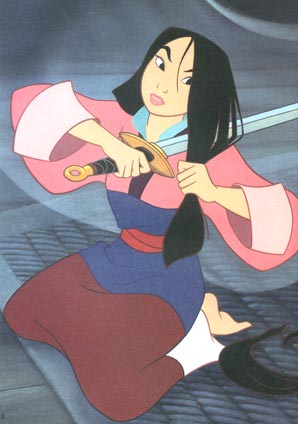 Hair can say a lot about one’s personality and through
tangled we see her different hairstyles can be based around her changing and
experiencing new things throughout her life. Tangled is a Disney animated movie
based on the German fairytale Rapunzel by The Grim Brothers. In this movie Rapunzel
has magical hair that allows her to heal and make the old young when she sings “Flower, gleam and glow, Let your power shine, Make the clock
reverse, Bring back what once was mine, Heal what has been hurt, Change the fate's design, Save what had been lost, Bring back what once was mine, What once was mine.” This power was
obtained through the magical golden flower that was said to have grown when a
single drop of sunlight from the heavens fell. When the queen was pregnant with
Rapunzel she fell ill and almost died, it was only due to this flower that she
drank that she lived and that is where Rapunzel got
Hair can say a lot about one’s personality and through
tangled we see her different hairstyles can be based around her changing and
experiencing new things throughout her life. Tangled is a Disney animated movie
based on the German fairytale Rapunzel by The Grim Brothers. In this movie Rapunzel
has magical hair that allows her to heal and make the old young when she sings “Flower, gleam and glow, Let your power shine, Make the clock
reverse, Bring back what once was mine, Heal what has been hurt, Change the fate's design, Save what had been lost, Bring back what once was mine, What once was mine.” This power was
obtained through the magical golden flower that was said to have grown when a
single drop of sunlight from the heavens fell. When the queen was pregnant with
Rapunzel she fell ill and almost died, it was only due to this flower that she
drank that she lived and that is where Rapunzel got
We see
Rapunzel trapped in the tower for the first 18 years of her life. She had a
routine of painting, baking and reading the same books over and over again. The
long hair that Rapunzel had could be seen as holding her down. One good imagery
part of the movie is when Rapunzel has to lift her mother up the tower each day
with her hair. Her mother is the one person that weighs
her down from being the
person that she truly wants to be. This all changes when Flynn Rider, also
known as Eugene Fitzherbert, shows up in the tower to get away from the kingdom
police because he stole the lost princesses crown. When Rapunzel see’s Flynn
for the first time (after she freaks out in fear) she demands that he takes her
to see the “lights in the sky” also known as floating lanterns. This is where
the true adventure begins. When their journey begins Rapunzel has this new
found view on the world, just like a child seeing things for the first time.
When Rapunzel begins to get into her first accouter in danger is when her secret
is revealed to Flynn. This is
an important time in the movie because her true
identity is revealed to Flynn and they are finally truthful with each other. As
they go into the kingdom we see Rapunzel experiencing parties and celebrations
for the first time. This is where her hair changes to more of a child
hairstyle. Four little girls braid her hair with flowers intertwined in them
like they had their own hair styled. The next change in hair is when she is
released from her mother’s burden when Flynn cuts off all of her hair. Rapunzel’s
hair loses all power and turns brown and the mother dies. This is when she
begins to experience her life as it should have been with her real family. She
is reunited with the king and queen and they live happily ever after.  There are many cases in the real world where we can see that
hair truly can change a personality. One drastic transformation in celebrities
can be found when we look at Miley Cyrus. She has gone from the good girl on
Hanna Montana, to the stage where she was dating Liam, to her current unknown
stage. Each stage can easily identified as a new stage in her life, her current
stage is what she says she has always been hiding. Hair tells a lot about a
person, it can show there mood or the personality of a person. Rapunzel changed
as her hair evolved, she became herself once she found just the right style.
There are many cases in the real world where we can see that
hair truly can change a personality. One drastic transformation in celebrities
can be found when we look at Miley Cyrus. She has gone from the good girl on
Hanna Montana, to the stage where she was dating Liam, to her current unknown
stage. Each stage can easily identified as a new stage in her life, her current
stage is what she says she has always been hiding. Hair tells a lot about a
person, it can show there mood or the personality of a person. Rapunzel changed
as her hair evolved, she became herself once she found just the right style.
Ethical Questions:
-Does
the style of one’s hair truly affect their mood and personality?
-Can a
person actually tell who a person is through their hair style?




















